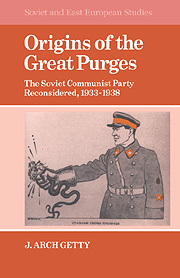Book contents
- Frontmatter
- Contents
- List of tables
- Preface
- Introduction: the Great Purges as history
- 1 The Communist Party in the thirties
- 2 What was a purge?
- 3 The Verification of Party Documents of 1935: a case study in bureaucratic ineptitude
- 4 Radicalism and party revival
- 5 Radicalism and enemies of the people
- 6 The crisis matures: 1937
- 7 Epilogue: the Ezhovshchina
- Conclusion: some observations on politics in the thirties
- Appendix: the Kirov assassination
- Bibliographic essay
- Notes
- Index
- SOVIET AND EAST EUROPEAN STUDIES
2 - What was a purge?
Published online by Cambridge University Press: 23 September 2009
- Frontmatter
- Contents
- List of tables
- Preface
- Introduction: the Great Purges as history
- 1 The Communist Party in the thirties
- 2 What was a purge?
- 3 The Verification of Party Documents of 1935: a case study in bureaucratic ineptitude
- 4 Radicalism and party revival
- 5 Radicalism and enemies of the people
- 6 The crisis matures: 1937
- 7 Epilogue: the Ezhovshchina
- Conclusion: some observations on politics in the thirties
- Appendix: the Kirov assassination
- Bibliographic essay
- Notes
- Index
- SOVIET AND EAST EUROPEAN STUDIES
Summary
In this area we can make very big mistakes.
E. M. Iaroslavskii, 1929Western students have applied the word “purge” to everything from political trials to police terror to nonpolitical expulsions from the party. The label “Great Purges,” which encompasses practically all party activities between 1933 and 1939, is an example of such broad usage. Yet the Communist Party defined and used the word quite specifically. The term “purge” (chistka–a sweeping or cleaning) only applied to the periodic membership screenings of the ranks of the party. These membership operations were designed to weed the party of hangers-on, nonparticipants, drunken officials, and people with false identification papers, as well as ideological “enemies” or “aliens.” In the majority of purges, political crimes or deviations pertained to a minority of those expelled.
No Soviet source or usage ever referred to the Ezhovshchina (the height of police arrests and terror in 1937) as a purge, and party leaders discussed that event and purges in entirely separate contexts. No political or nonpolitical trial was ever called a purge, and under no circumstances were operations, arrests, or terror involving nonparty citizens referred to as purges. A party member at the time would have been mystified by such a label.
To understand the political events of the thirties in the Communist Party and in the USSR, it is necessary briefly to review various elements of the party's history and tradition: definitions of membership, principles of organization, and the theory and practice of purging the party. The following discussion reviews these norms and traditions as they developed in the late 1920s, using the party purges of 1929 and 1933 as examples of the accumulated experience of the period.
- Type
- Chapter
- Information
- Origins of the Great PurgesThe Soviet Communist Party Reconsidered, 1933–1938, pp. 38 - 57Publisher: Cambridge University PressPrint publication year: 1985



